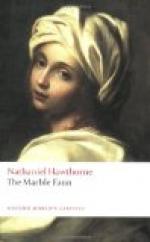Here, as it seemed, had the Golden Age come back again within the Precincts of this sunny glade, thawing mankind out of their cold formalities, releasing them from irksome restraint, mingling them together in such childlike gayety that new flowers (of which the old bosom of the earth is full) sprang up beneath their footsteps. The sole exception to the geniality of the moment, as we have understood, was seen in a countryman of our own, who sneered at the spectacle, and declined to compromise his dignity by making part of it.
The harper thrummed with rapid fingers; the violin player flashed his bow back and forth across the strings; the flautist poured his breath in quick puffs of jollity, while Donatello shook the tambourine above his head, and led the merry throng with unweariable steps. As they followed one another in a wild ring of mirth, it seemed the realization of one of those bas-reliefs where a dance of nymphs, satyrs, or bacchanals is twined around the circle of an antique vase; or it was like the sculptured scene on the front and sides of a sarcophagus, where, as often as any other device, a festive procession mocks the ashes and white bones that are treasured up within. You might take it for a marriage pageant; but after a while, if you look at these merry-makers, following them from end to end of the marble coffin, you doubt whether their gay movement is leading them to a happy close. A youth has suddenly fallen in the dance; a chariot is overturned and broken, flinging the charioteer headlong to the ground; a maiden seems to have grown faint or weary, and is drooping on the bosom of a friend. Always some tragic incident is shadowed forth or thrust sidelong into the spectacle; and when once it has caught your eye you can look no more at the festal portions of the scene, except with reference to this one slightly suggested doom and sorrow.
As in its mirth, so in the darker characteristic here alluded to, there was an analogy between the sculptured scene on the sarcophagus and the wild dance which we have been describing. In the midst of its madness and riot Miriam found herself suddenly confronted by a strange figure that shook its fantastic garments in the air, and pranced before her on its tiptoes, almost vying with the agility of Donatello himself. It was the model.
A moment afterwards Donatello was aware that she had retired from the dance. He hastened towards her, and flung himself on the grass beside the stone bench on which Miriam was sitting. But a strange distance and unapproachableness had all at once enveloped her; and though he saw her within reach of his arm, yet the light of her eyes seemed as far off as that of a star, nor was there any warmth in the melancholy smile with which she regarded him.
“Come back!” cried he. “Why should this happy hour end so soon?”
“It must end here, Donatello,” said she, in answer to his words and outstretched hand; “and such hours, I believe, do not often repeat themselves in a lifetime. Let me go, my friend; let me vanish from you quietly among the shadows of these trees. See, the companions of our pastime are vanishing already!”




